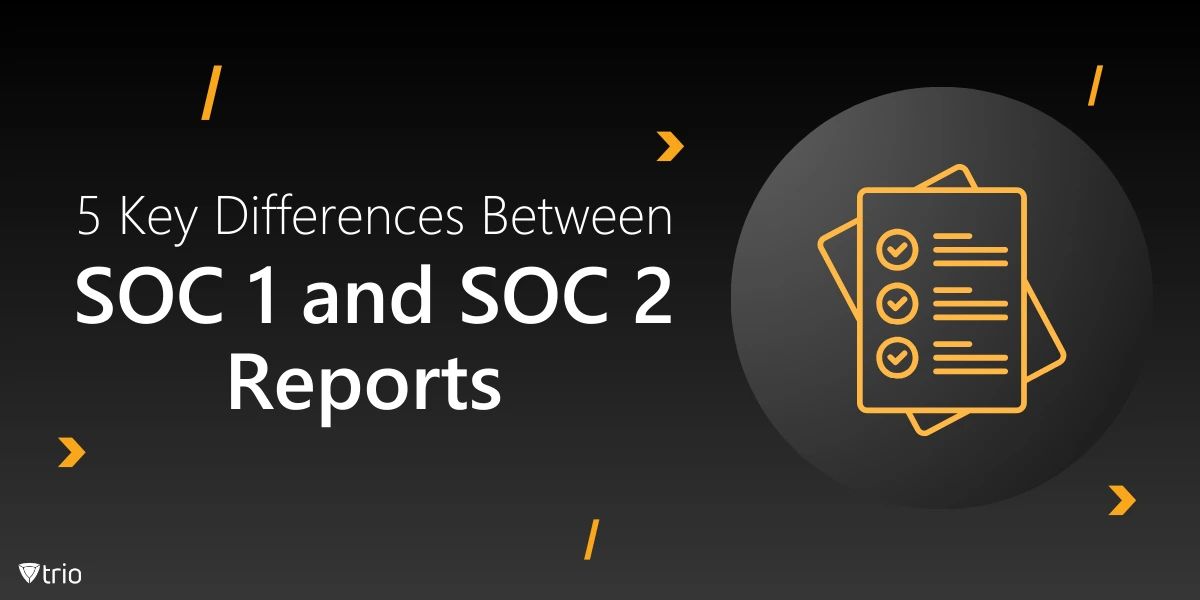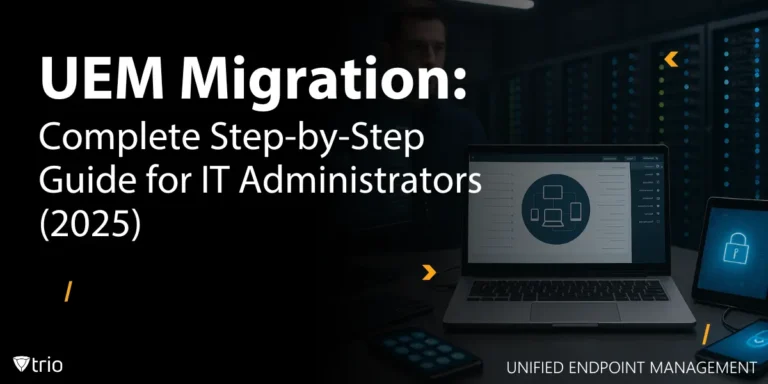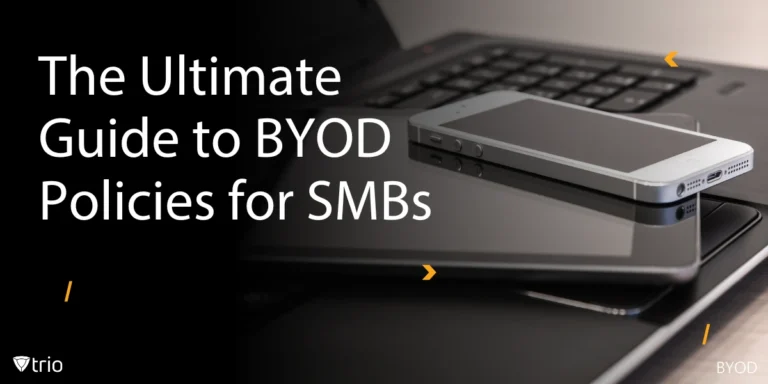As businesses grow and rely on third-party vendors to manage sensitive data and services, ensuring proper security and compliance becomes a priority. This need has given rise to various types of System and Organization Controls (SOC) reports, with SOC 1 and SOC 2 being among the most critical. These reports assess different aspects of service organizations, but it’s essential to understand the differences between SOC 1 vs SOC 2 when navigating IT compliance.
In this blog post, we will explore five key differences between SOC 1 and SOC 2 reports, highlighting their distinct roles in compliance frameworks. By the end, you'll know the types of SOC reports and how they relate to your organization's needs for auditing and compliance.
Introduction to SOC 1 and SOC 2 Reports
SOC reports, established by the American Institute of Certified Public Accountants (AICPA), play an important role in ensuring that service organizations maintain appropriate controls over data and processes. Both SOC 1 and SOC 2 audits evaluate the effectiveness of internal controls, but they target different types of risks and compliance requirements.
SOC 1 reports focus on the controls relevant to financial reporting, specifically examining how a service organization’s systems could impact the accuracy of financial data. On the other hand, SOC 2 reports emphasize the security and availability of systems, processing integrity, confidentiality, and privacy of sensitive data.
Understanding these distinctions is vital when considering the types of SOC reports that align with your business goals.
1- Focus and Scope of the Audits
The primary difference between SOC 1 and SOC 2 lies in their focus and scope. SOC 1 audits assess internal controls over financial reporting (ICFR). These reports are particularly relevant for organizations whose services affect the financial reporting of their clients. SOC 1 compliance requirements, therefore, revolve around ensuring accurate financial information flows between service organizations and their clients.
SOC 2, however, is more focused on non-financial reporting controls that ensure security, availability, processing integrity, confidentiality, and privacy of the systems a service organization uses to handle sensitive data. SOC 2 audits evaluate how well these systems protect data from breaches and maintain the reliability of operations. For businesses such as cloud service providers, data centers, and IT management firms, SOC 2 compliance requirements are crucial to safeguarding customer information.

2- Types of Reports
Another key difference between SOC 1 and SOC 2 is the types of reports issued. SOC 1 and SOC 2 reports come in two forms: Type 1 and Type 2.
Type 1 reports examine the design of controls at a specific point in time. They provide a snapshot of whether the necessary controls are in place to manage risks. In contrast, Type 2 reports go further by evaluating the operating effectiveness of those controls over a period, offering deeper insights into how well the controls function in practice.
For example, an SOC 1 Type 1 report may assess the financial controls in place for a specific date, whereas a SOC 1 Type 2 report will test how those controls operated over a six- or twelve-month period. Similarly, SOC 2 reports follow the same pattern, with Type 2 reports offering a broader view of compliance over time, such as how data protection protocols were enforced over months.
3- Compliance Requirements and Standards
The compliance requirements for SOC 1 and SOC 2 are aligned with different regulatory standards and guidelines. SOC 1 audits are concerned with the accuracy and completeness of financial reporting. Thus, SOC 1 compliance requirements generally relate to the financial impact that a service organization’s systems can have on their clients' financial statements. Businesses dealing with financial data or systems that influence financial records, such as payroll or billing platforms, typically undergo SOC 1 audits to assure clients of their controls over financial reporting.
SOC 2, on the other hand, is aligned with the Trust Services Criteria, which include security, availability, processing integrity, confidentiality, and privacy. SOC 2 compliance requirements focus on ensuring that a service organization can protect sensitive data and maintain operational integrity. Organizations that process large volumes of sensitive data, such as customer information or intellectual property, must demonstrate strong controls in these areas through SOC 2 audits to reduce the risk of data breaches.
4- Audience and Use Cases
SOC 1 and SOC 2 reports also differ in terms of their intended audience and use cases. SOC 1 reports are primarily geared toward the needs of business partners, financial auditors, and organizations that depend on third-party services affecting their internal controls over financial reporting. These reports are crucial for companies that need assurance that their financial information is accurate and secure, especially when it involves outsourcing financial operations.
SOC 2 reports, by contrast, are more broadly used to meet the needs of IT professionals, security teams, and clients concerned with the privacy and integrity of their sensitive data. These reports are commonly used by cloud service providers, IT management firms, and data centers to assure their clients that they have robust security and privacy controls in place.
Additionally, some organizations opt to receive SOC 3 reports, which are summaries of SOC 2 audits meant for general distribution. SOC 3 reports provide limited detail compared to SOC 2 but are useful for marketing purposes or public assurance.
5- Controls and Testing Criteria
The controls assessed in SOC 1 and SOC 2 audits are fundamentally different. SOC 1 controls are focused on financial reporting and typically examine processes such as payroll, billing, and accounting. The testing criteria for SOC 1 audits involve verifying that the service organization's internal controls over financial reporting are effective and reliable.
In contrast, SOC 2 audits examine controls related to system security, availability, and confidentiality, testing criteria around how well the systems protect data and ensure uninterrupted service. For example, SOC 2 controls might include encryption protocols, access controls, and incident response plans to prevent data breaches. Testing in SOC 2 audits often involves simulated attacks and penetration testing to ensure that systems can withstand cyber threats.
Compliance Training Best Practices
Effective compliance training is essential for ensuring that employees understand and adhere to regulatory requirements. Best practices include regularly updating training materials to reflect the latest standards, such as SOC 1 and SOC 2 compliance guidelines, and tailoring content to specific roles within the organization. Incorporating interactive elements, such as quizzes and real-life scenarios, enhances engagement and retention. It's also important to track participation and outcomes through compliance monitoring software, ensuring that employees stay informed about changing regulations like NIST Compliance and the California Consumer Privacy Act.

How Trio Can Help with SOC 1 and SOC 2 Compliance
As an MDM solution, Trio can help your business meet both SOC 1 and SOC 2 compliance requirements. Trio’s features are designed to ensure security and control over financial and non-financial systems alike. By integrating system and organization controls through its platform, Trio helps IT administrators manage devices and safeguard sensitive data across your organization’s networks. Trio also streamlines compliance automation, reducing the burden of manual tasks when it comes to SOC 1 and SOC 2 audits.
By using Trio, you can enhance your internal controls over financial reporting and system security, ultimately supporting your SOC 1 and SOC 2 compliance journey. For a deeper understanding of how Trio’s MDM solution can support your SOC compliance needs, schedule a free demo today.
Conclusion
Understanding the key differences between SOC 1 and SOC 2 reports is critical for businesses seeking compliance with financial and data security standards. While SOC 1 focuses on financial controls, SOC 2 emphasizes security and privacy, each report targeting different aspects of your business operations.
As businesses continue to outsource critical services, knowing which types of SOC reports to request from service providers will ensure that you maintain compliance and protect your organization’s most valuable assets.
Get Ahead of the Curve
Every organization today needs a solution to automate time-consuming tasks and strengthen security.
Without the right tools, manual processes drain resources and leave gaps in protection. Trio MDM is designed to solve this problem, automating key tasks, boosting security, and ensuring compliance with ease.
Don't let inefficiencies hold you back. Learn how Trio MDM can revolutionize your IT operations or request a free trial today!





